TAKARA公司的5' full RACE说明书
- 格式:pdf
- 大小:427.59 KB
- 文档页数:15
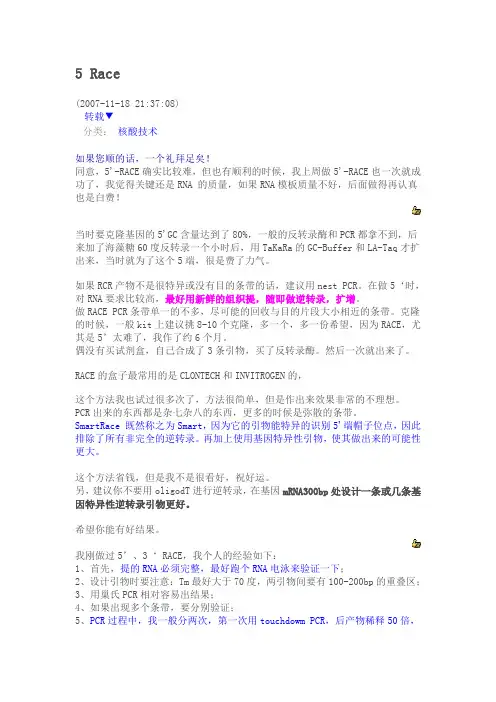
5 Race(2007-11-18 21:37:08)转载▼分类:核酸技术如果您顺的话,一个礼拜足矣!同意,5'-RACE确实比较难,但也有顺利的时候,我上周做5'-RACE也一次就成功了,我觉得关键还是RNA 的质量,如果RNA模板质量不好,后面做得再认真也是白费!当时要克隆基因的5'GC含量达到了80%,一般的反转录酶和PCR都拿不到,后来加了海藻糖60度反转录一个小时后,用TaKaRa的GC-Buffer和LA-Taq才扩出来,当时就为了这个5端,很是费了力气。
如果RCR产物不是很特异或没有目的条带的话,建议用nest PCR。
在做5‘时,对RNA要求比较高,最好用新鲜的组织提,随即做逆转录,扩增。
做RACE PCR条带单一的不多,尽可能的回收与目的片段大小相近的条带。
克隆的时候,一般kit上建议挑8-10个克隆,多一个,多一份希望,因为RACE,尤其是5’太难了,我作了约6个月。
偶没有买试剂盒,自己合成了3条引物,买了反转录酶。
然后一次就出来了。
RACE的盒子最常用的是CLONTECH和INVITROGEN的,这个方法我也试过很多次了,方法很简单,但是作出来效果非常的不理想。
PCR出来的东西都是杂七杂八的东西,更多的时候是弥散的条带。
SmartRace 既然称之为Smart,因为它的引物能特异的识别5'端帽子位点,因此排除了所有非完全的逆转录。
再加上使用基因特异性引物,使其做出来的可能性更大。
这个方法省钱,但是我不是很看好,祝好运。
另,建议你不要用oligodT进行逆转录,在基因mRNA300bp处设计一条或几条基因特异性逆转录引物更好。
希望你能有好结果。
我刚做过5’、3‘ RACE,我个人的经验如下:1、首先,提的RNA必须完整,最好跑个RNA电泳来验证一下;2、设计引物时要注意:Tm最好大于70度,两引物间要有100-200bp的重叠区;3、用巢氏PCR相对容易出结果;4、如果出现多个条带,要分别验证;5、PCR过程中,我一般分两次,第一次用touchdowm PCR,后产物稀释50倍,作二次,72度尽量长一点,我们一般用2-3min;6、结果分析,最好是重叠区吻合,否则,应重新做。
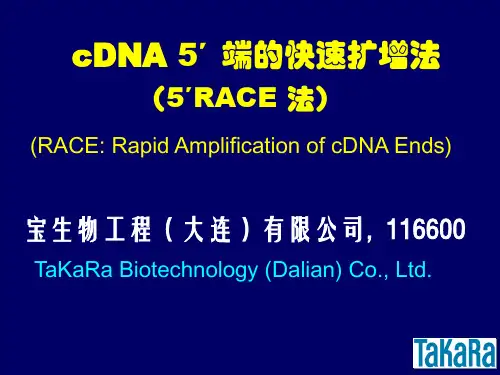

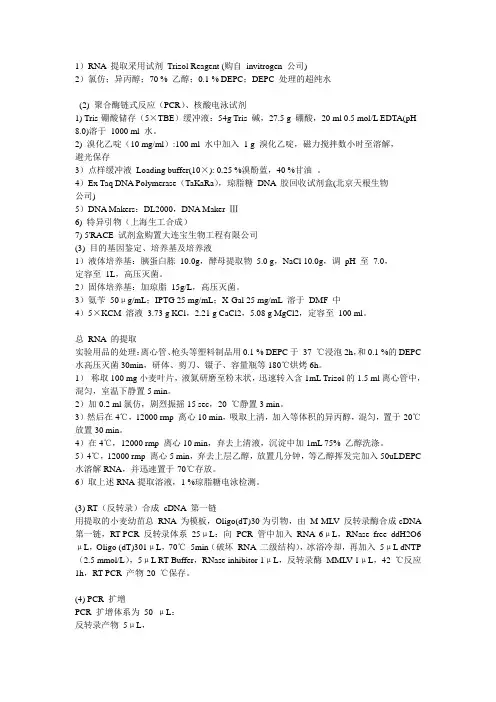
1)RNA 提取采用试剂Trizol Reagent (购自invitrogen 公司)2)氯仿;异丙醇;70 % 乙醇;0.1 % DEPC;DEPC 处理的超纯水(2) 聚合酶链式反应(PCR)、核酸电泳试剂1) Tris-硼酸储存(5×TBE)缓冲液:54g Tris 碱,27.5 g 硼酸,20 ml 0.5 mol/L EDTA(pH 8.0)溶于1000 ml 水。
2) 溴化乙啶(10 mg/ml):100 ml 水中加入1 g 溴化乙啶,磁力搅拌数小时至溶解,避光保存3)点样缓冲液Loading buffer(10×): 0.25 %溴酚蓝,40 %甘油。
4)Ex Taq DNA Polymerase(TaKaRa),琼脂糖DNA 胶回收试剂盒(北京天根生物公司)5)DNA Makers:DL2000,DNA Maker Ⅲ6) 特异引物(上海生工合成)7) 5'RACE 试剂盒购置大连宝生物工程有限公司(3) 目的基因鉴定、培养基及培养液1)液体培养基:胰蛋白胨10.0g,酵母提取物5.0 g,NaCl 10.0g,调pH 至7.0,定容至1L,高压灭菌。
2)固体培养基:加琼脂15g/L,高压灭菌。
3)氨苄50μg/mL;IPTG 25 mg/mL;X-Gal 25 mg/mL 溶于DMF 中4)5×KCM 溶液3.73 g KCl,2.21 g CaCl2,5.08 g MgCl2,定容至100 ml。
总RNA 的提取实验用品的处理:离心管、枪头等塑料制品用0.1 % DEPC于37 ℃浸泡2h,和0.1 %的DEPC 水高压灭菌30min,研体、剪刀、镊子、容量瓶等180℃烘烤6h。
1)称取100 mg小麦叶片,液氮研磨至粉末状,迅速转入含1mL Trizol的1.5 ml离心管中,混匀,室温下静置5 min。
2)加0.2 ml氯仿,剧烈振摇15 sec,20 ℃静置3 min。

TaKaRa Code:D3155’-Full RACE Kit(10次量)目录内容页码●制品说明 1 ●制品内容 1 ●保存 2 ●试剂盒原理 2 ●特异性引物的设计要求 3 ●试剂盒特点 3 ●RNA样品制备 3 ●试剂盒使用注意 4 ●使用Control HL60 Total RNA时的5′RACE实验例 4 ●实验样品的5′RACE操作方法 8 ●实验例 11 ●Q&A 11●制品说明本试剂盒是高灵敏度、高特异性扩增cDNA 5′末端全长的试剂盒。
使用RT-PCR方法扩增目的DNA时,一般很难得到全长的cDNA片段,在基因工程研究中,分析遗传基因的全长cDNA序列十分重要。
RACE (Rapid Amplification of cDNA Ends)法能有效解决这一问题。
TaKaRa 5′-Full RACE Kit能够通过已知的cDNA序列,高灵敏度、高特异性地扩增cDNA的5′末端的全长序列。
本试剂盒应用了“去帽法”原理,Tobacco Acid Pyrophosphatase(TAP)可以去掉mRNA的5′帽子结构,使用T4 RNA Ligase将5′RACE Adaptor连接到mRNA的5′端后,可以使用5′RACE Adaptor 上的引物与已知序列部分的引物进行RT-PCR反应,高特异性地扩增cDNA 5′末端的全长序列。
本试剂盒中含有完成5′RACE操作的主要试剂。
试剂盒中使用的Reverse Transcriptase M-MLV(RNase H-)经过了本公司的特殊改良,反转录性能良好,无RNase H活性,大大增加了反转录性能。
结合使用TaKaRa LA Taq®(TaKaRa Code:DRR02AM)进行PCR扩增时,其5′RACE的扩增性能大大优于其他同类产品。
本试剂盒应用了套式PCR原理,增加了PCR扩增的特异性与灵敏度,可以对少量样品或低丰度的基因进行5′RACE实验,并且对长片段的5′RACE扩增具有明显优势。
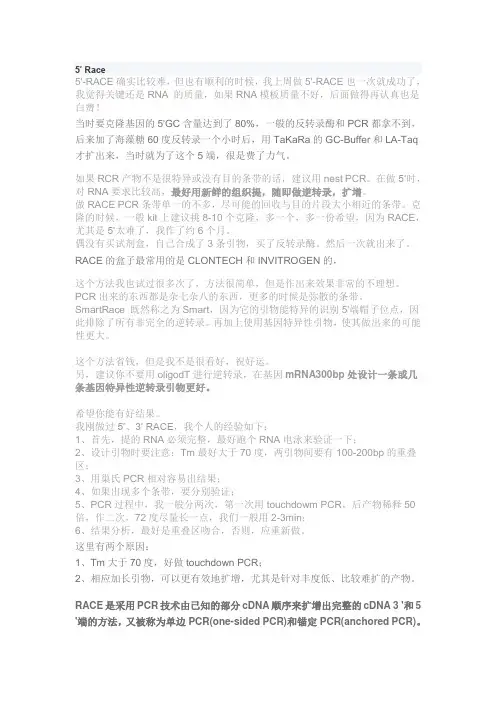
5’ Race5'-RACE确实比较难,但也有顺利的时候,我上周做5'-RACE也一次就成功了,我觉得关键还是RNA 的质量,如果RNA模板质量不好,后面做得再认真也是白费!当时要克隆基因的5'GC含量达到了80%,一般的反转录酶和PCR都拿不到,后来加了海藻糖60度反转录一个小时后,用TaKaRa的GC-Buffer和LA-Taq才扩出来,当时就为了这个5端,很是费了力气。
如果RCR产物不是很特异或没有目的条带的话,建议用nest PCR。
在做5‘时,对RNA要求比较高,最好用新鲜的组织提,随即做逆转录,扩增。
做RACE PCR条带单一的不多,尽可能的回收与目的片段大小相近的条带。
克隆的时候,一般kit上建议挑8-10个克隆,多一个,多一份希望,因为RACE,尤其是5’太难了,我作了约6个月。
偶没有买试剂盒,自己合成了3条引物,买了反转录酶。
然后一次就出来了。
RACE的盒子最常用的是CLONTECH和INVITROGEN的,这个方法我也试过很多次了,方法很简单,但是作出来效果非常的不理想。
PCR出来的东西都是杂七杂八的东西,更多的时候是弥散的条带。
SmartRace 既然称之为Smart,因为它的引物能特异的识别5'端帽子位点,因此排除了所有非完全的逆转录。
再加上使用基因特异性引物,使其做出来的可能性更大。
这个方法省钱,但是我不是很看好,祝好运。
另,建议你不要用oligodT进行逆转录,在基因mRNA300bp处设计一条或几条基因特异性逆转录引物更好。
希望你能有好结果。
我刚做过5’、3‘ RACE,我个人的经验如下:1、首先,提的RNA必须完整,最好跑个RNA电泳来验证一下;2、设计引物时要注意:Tm最好大于70度,两引物间要有100-200bp的重叠区;3、用巢氏PCR相对容易出结果;4、如果出现多个条带,要分别验证;5、PCR过程中,我一般分两次,第一次用touchdowm PCR,后产物稀释50倍,作二次,72度尽量长一点,我们一般用2-3min;6、结果分析,最好是重叠区吻合,否则,应重新做。
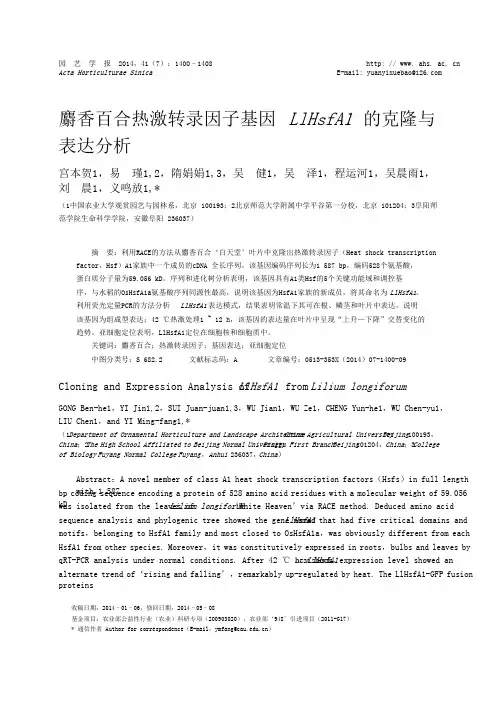
园艺学报2014,41(7):1400–1408 http: // www. ahs. ac. cn Acta Horticulturae Sinica E-mail: yuanyixuebao@ 麝香百合热激转录因子基因LlHsfA1的克隆与表达分析宫本贺1,易瑾1,2,隋娟娟1,3,吴健1,吴泽1,程运河1,吴晨雨1,刘晨1,义鸣放1,*(1中国农业大学观赏园艺与园林系,北京100193;2北京师范大学附属中学平谷第一分校,北京101204;3阜阳师范学院生命科学学院,安徽阜阳236037)摘要:利用RACE的方法从麝香百合‗白天堂‘叶片中克隆出热激转录因子(Heat shock transcription factor,Hsf)A1家族中一个成员的cDNA 全长序列。
该基因编码序列长为1 587 bp,编码528个氨基酸,蛋白质分子量为59.056 kD。
序列和进化树分析表明,该基因具有A1类Hsf的5个关键功能域和调控基序,与水稻的OsHsfA1a氨基酸序列同源性最高,说明该基因为HsfA1家族的新成员,将其命名为L lHsfA1。
利用荧光定量PCR的方法分析LlHsfA1表达模式,结果表明常温下其可在根、鳞茎和叶片中表达,说明该基因为组成型表达;42 ℃热激处理1 ~ 12 h,该基因的表达量在叶片中呈现―上升—下降‖交替变化的趋势。
亚细胞定位表明,LlHsfA1定位在细胞核和细胞质中。
关键词:麝香百合;热激转录因子;基因表达;亚细胞定位中图分类号:S 682.2 文献标志码:A 文章编号:0513-353X(2014)07-1400-09 Cloning and Expression Analysis of LlHsfA1from Lilium longiforumGONG Ben-he1,YI Jin1,2,SUI Juan-juan1,3,WU Jian1,WU Ze1,CHENG Yun-he1,WU Chen-yu1,LIU Chen1,and YI Ming-fang1,*(1 Department of Ornamental Horticulture and Landscape Architecture,C hina Agricultural University,B eijing100193,China;2 The High School Affiliated to Beijing Normal University,Pinggu First Branch,B eijing 101204,C hina;3 Collegeof Biology,F uyang Normal College,F uyang,A nhui236037,China)Abstract:A novel member of class A1 heat shock transcription factors(Hsfs)in full length with 1 587 bp coding sequence encoding a protein of 528 amino acid residues with a molecular weight of 59.056 kDwas isolated from the leaves of Lilium longiforum‗White Heaven‘via RACE method. Deduc ed amino acid sequence analysis and phylogenic tree showed the gene named LlHsfA1that had five critical domains and motifs,belonging to HsfA1 family and most closed to OsHsfA1a,was obviously different from eachHsfA1 from other species. Moreover,it was constitutively expressed in roots,bulbs and leaves byqRT-PCR analysis under normal conditions. After 42 ℃heat shock,LlHsfA1 expression level showed an alternate trend of‗rising and falling‘,remarkably up-regulated by heat. The LlHsfA1-GFP fusion proteins收稿日期:2014–01–06;修回日期:2014–05–08基金项目:农业部公益性行业(农业)科研专项(200903020);农业部‗948‘引进项目(2011-G17)* 通信作者Author for correspondence(E-mail:ymfang@)7期宫本贺等:麝香百合热激转录因子基因LlHsfA1的克隆与表达分析1401were observed to be located in the nucleus and cytoplasm.Key words:L ilium longiforum;heat shock transcription factor;gene expression;subcellular location百合(L ilium)品种繁多,喜冷凉湿润气候,但耐热性较差。

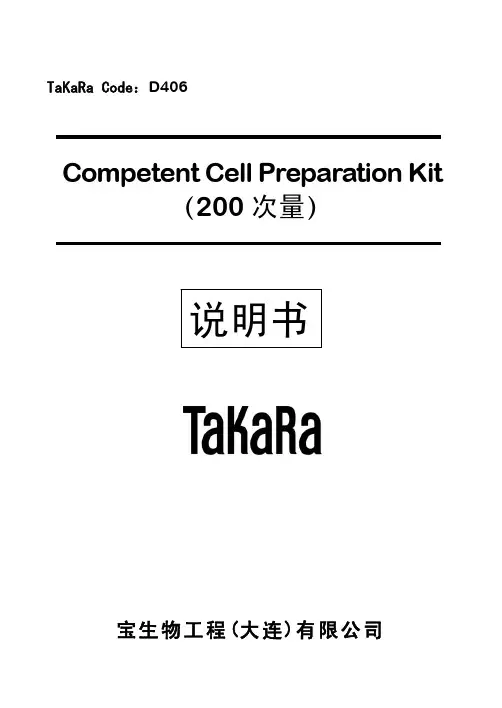
TaKaRa Code:D406Competent Cell Preparation Kit次(200量)宝生物工程(大连)有限公司目录内 容 页 码●制品说明 1●制品内容 1●制品保存 1●使用注意 1●感受态细胞的制备方法 1●感受态细胞的DNA转化 2●实验例 2●相关试剂及培养基的制备方法 3■Ampicillin 3■IPTG 3■X-Gal 3■LB培养基 3■LB/Amp培养基 3■SOB培养基 3■SOC培养基 4■φb×broth 4■LB/Amp/X-Gal/IPTG平板培养基 4●制品说明大肠杆菌经过处理后可以摄取外源DNA(Plasmid DNA、Phage DNA等),处于这种状态的细胞称为感受态细胞(Competent Cell)。
在基因工程实验中,经常要使用各种感受态细胞进行DNA的转化操作。
实验使用的感受态细胞的来源大体可以分为两种:一种是购买商品化的感受态细胞,但商品化感受态细胞成本高、运输及保存有一定困难(超低温);另一种是自己制备感受态细胞,实验人员自己制作感受态细胞时,往往受到各种试剂及实验条件等限制,制备的感受态细胞效率低,达不到实验要求。
TaKaRa Competent Cell Preparation Kit是一种方便、高效、快速制备感受态细胞的试剂盒。
使用本试剂盒制备的感受态细胞可以满足大多数实验的需要,并且适用于几乎所有常用的大肠杆菌,例如:E.coli DH5α、JM109、CJ236、HB101、MV1184、BMH71-18mut S等,转化效率均可以达到1×106 cfu/μg pUC19以上(转化效率根据大肠杆菌细胞系及转化用DNA不同稍有差异)。
使用本试剂盒制备的感受态细胞可以在-80℃保存一年。
●制品内容(200次量)Solution A 20 mlSolution B 20 ml●制品保存:4℃保存。
●使用注意1.制作感受态细胞时应使用专用的玻璃器皿或塑料容器。
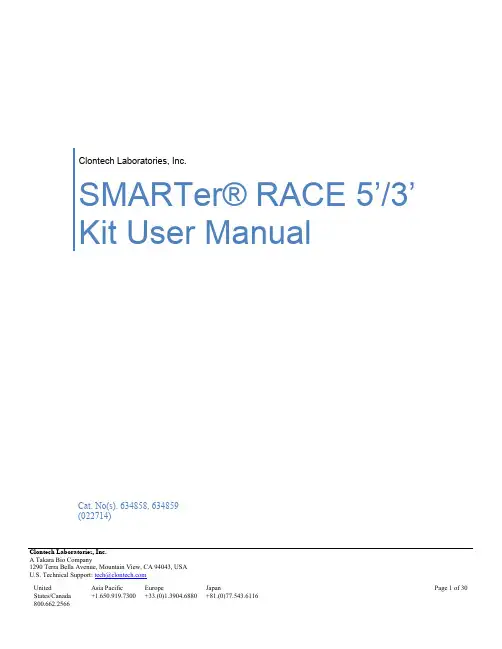
Clontech Laboratories, Inc.SMARTer® RACE 5’/3’Kit User ManualCat. No(s). 634858, 634859(022714)Clontech Laboratories, Inc.A Takara Bio Company1290 Terra Bella Avenue, Mountain View, CA 94043, USAU.S. Technical Support: tech@United Asia Pacific Europe Japan Page 1 of 30I. Introduction (4)II. List of Components (7)III. Additional Materials Required (8)IV. Primer Design (9)A. Primer Sequence (9)B. Additional Considerations for Design (10)C. Location of Primer Sequences within Genes (10)D. Nested Primers (10)V. Generating RACE-Ready cDNA (11)A. General Considerations (11)B. Preparation and Handling of Total and Poly A+ RNA (11)C. Assessing RNA Template Quality (12)D. Protocol: First-Strand cDNA Synthesis (13)VI. Rapid Amplification of cDNA Ends (RACE) (15)A. Things You Should Know Before Starting RACE PCR Reactions (15)B. Protocol: Rapid Amplification of cDNA Ends (RACE) (15)VII. Characterization of RACE Products (17)A. Protocol: Gel Extraction with the NuceloSpin Gel and PCR Clean-Up Kit (17)B. Protocol: In-Fusion Cloning of RACE Products (18)C. Sequencing RACE Products (19)VIII. References (20)Appendix A. Troubleshooting Guide (21)A. Troubleshooting Touchdown PCR (21)B. Multiple Band RACE Products (23)C. Other Specific Problems (25)Ap pendix B. Detailed Flow Chart of 5’ RACE (27)Appendix C. Detailed Flow Chart of 3’ RACE (28)Appendix D. 5’-RACE cDNA Amplification with Random Primers (29)A. Protocol: First-Strand cDNA Synthesis with Random Priming (29)Figure 1. Mechanism of SMARTer cDNA synthesis (4)Figure 2. Overview of the SMARTer RACE procedure.. (6)Figure 3. The relationship of gene-specific primers to the cDNA template. (9)Figure 4. 5'- and 3'-RACE sample results (22)Figure 5. Detailed mechanism of the 5'-RACE reactions. (27)Figure 6. Detailed mechanism of the 3'-RACE reactions. (28)Table of TablesTable 1. Additional 5'-RACE Sequence Obtained with SMART Technology (5)Table 2. Setting up 5'- and 3'-RACE PCR Reactions (15)Table 3. Troubleshooting Guide: Other Specific Problems (25)I. IntroductionThe SMARTer RACE 5’/3’ Kit provides a method for performing both 5’- and 3’-rapid amplification of cDNA ends (RACE). The SMARTer RACE 5’/3’ Kit includes our SMARTer II A Oligonucleotide and SMARTScribe™Reverse Transcriptase, which provides better sensitivity, less background and higher specificity than previouskits. This powerful system allows you to amplify the complete 5’ sequence of your target transcript from as little as 10 ng of total RNA. The cornerstone of SMARTer RACE cDNA synthesis is SMART™ technology, which eliminates the need for problematic adaptor ligation and lets you use first-strand cDNA directly in RACE PCR, a benefit that makes RACE far less complex and much faster (Chenchik et al., 1998). Additionally, the SMARTer RACE Kit exploits Clontech’s technology for suppression PCR & step-out PCR to increase the sensitivity andreduce the background of the RACE reactions. You can use either poly A+ or total RNA as starting material for constructing full-length cDNAs, even of very rare transcripts.The SMARTer RACE 5’/3’ Kit is an improved version of our original SMARTer RACE cDNA Amplification Kit, designed to accommodate larger RNA input volumes and perform more efficiently on challenging targets(e.g., those that are long, GC-rich, etc.). RACE PCR products are amplified with our highly robust SeqAmp™DNA Polymerase, and cloned into the linearized pRACE vector with In-Fusion® HD Cloning. The In-Fusion HD Cloning Kit, NucleoSpin Gel and PCR Clean-Up Kit, and Stellar™ Competent Cel ls are included for yourconvenience in cloning RACE products.SMART technology provides a mechanism for generating full-length cDNAs in reverse transcription reactions (Zhu et al., 2001). This is made possible by the joint action of the SMARTer II A Oligonucleotide andSMARTScribe Reverse Transcriptase. When the SMARTScribe RT reaches the 5’ end of the RNA, its terminal transferase activity adds a few additional nucleotides to the 3’ end of the first-strand cDNA (Figure 1).Figure 1. Mechanism of SMARTer cDNA synthesis.First-strand cDNA synthesis is primed using a modified oligo (dT) primer. After SMARTScribe Reverse Transcriptase (RT) reaches the end of the mRNA template, it adds several nontemplated residues. The SMARTer IIA Oligonucleotide anneals to the tail of the cDNA and serves as an extended template for SMARTScribe RT.The SMARTer II A Oligonucleotide contains a terminal stretch of modified bases that anneal to the extended cDNA tail, allowing the oligo to serve as a template for the RT. SMARTScribe RT switches templates from the mRNA molecule to the SMARTer oligo, generating a complete cDNA copy of the original RNA with the additional SMARTer sequence at the end. Since the template switching activity of the RT occurs only when the enzyme reaches the end of the RNA template, the SMARTer sequence is typically only incorporated into full-length, first-strand cDNAs. This process guarantees that the use of high quality RNA will result in the formation of a set of cDNAs that have a maximum amount of 5’ sequence (Table I).Table 1. Additional 5'-RACE Sequence Obtained with SMART TechnologyHuman gene Size of mRNA(kb)Additional sequence(bp)*Matches genomicsequencesPiccolo presynaptic cytomatrix protein 20.29 +59 yesDynein, cytoplasmic 1, heavy chain 1 14.36 +36 yesPolycystic kidney disease 1 14.14 +21 yesSolute carrier family 1 12.02 +73 yes Microtubule-associated protein 1A 10.54 +13 yesSpectrin, beta, non-erythrocytic 10.24 +32 yesTransferrin receptor 5.0 +25 yesInterferon-α receptor 2.75 +17 yesSmooth muscle g-actin 1.28 +31 yesFollowing reverse transcription, SMART technology allows first-strand cDNA to be used directly in 5’- and3’-RACE PCR reactions. Incorporation of universal primer binding sites in a single-step during first-strand cDNA synthesis eliminates the need for tedious second-strand synthesis and adaptor ligation. This simple and highly efficient SMARTer cDNA synthesis method ensures higher specificity in amplifying your target cDNA. Suppression PCR & step-out PCR techniques are used in combination with SMARTer technology to decrease background amplification in RACE PCR.Requirements for SMARTer RACE cDNA AmplificationThe only requirement for SMARTer RACE cDNA amplification is that you know at least 23–28 nucleotides (nt) of sequence information in order to design gene-specific primers (GSPs) for the 5’- and 3’-RACE reactions. (Additional sequence information will facilitate analysis of your RACE products.) This limited requirement makes SMARTer RACE ideal for characterizing genes identified through diverse methods, including cDNA subtraction, differential display, RNA fingerprinting, ESTs, library screening, and more.Uses of SMARTer RACE cDNA AmplificationSMARTer RACE cDNA amplification is a flexible tool—many researchers use this kit in place of conventional kits to amplify just the 5’ or 3’ end of a particular cDNA. Others perform both 5’- and 3’-RACE, and many then go on to clone full-length cDNAs using one of the two methods described in the latter part of this protocol. In many cases, researchers obtain full-length cDNAs without ever constructing or screening a cDNA library.Figure 2. Overview of the SMARTer RACE procedure.Detailed flow charts of the SMARTer RACE mechanisms can be found in Appendices B & C. Alternatively, you can obtain the sequences of the extreme ends of the transcript by sequencing the 5’ end of the 5’ product and the 3’ end of the 3’ product. Using this information, you can design 5’ and 3’ gene-specific primers to use in LD PCR with the 5’-RACE-Ready cDNA as template to generate the full-length cDNA.Note that with the cloned RACE fragments you can use a restriction site in an overlapping region to construct a full-length cDNA by subcloning, or design new GSPs to generate PCR products compatible with In-Fusion cloning.II. List of ComponentsThis section lists the components for Cat. No. 634858, a 10 reaction kit. The larger, 20 reaction kit (Cat. No.634859) contains two of every item listed below.SMARTer RACE 5’/3’ Kit Components (Cat. No. 634860) (Not sold separately)Store SMARTer II A Oligonucleotide and Control Mouse Heart Total RNA at –70°C. Store all other components at –20°C.∙First-Strand cDNA Synthesiso10 µl SMARTer II A Oligonucleotide (24 μM)o10 µl 3' RACE CDS Primer A (12 μM)o10 µl 5' RACE CDS Primer A (12 μM)o10 µl 10X Random Primer Mix (20 μM)o40 µl 5X First-Strand Buffer (RNAse-Free)o 5 µl Dithiothreitol (DTT) (100 mM)o 1 ml Deionized H2Oo10 µl RNase Inhibitor (40 U/µl)o20 µl SMARTScribe Reverse Transcriptase (100 U/µl)o10 µl dNTP mix (20 mM)∙5’- and 3’-RACE PCRo400 µl 10X Universal Primer A Mix (UPM)o50 µl Universal Primer Short (10 µM)o 5 µl Control Mouse Heart Total RNA (1 µg/µl)o25 µl Control 5'-RACE TFR Primer (10 µM; designed for compatibility with In-Fusion cloning)o25 µl Control 3'-RACE TFR Primer (10 µM; designed for compatibility with In-Fusion cloning) ∙In-Fusion Cloningo10 µl Linearized pRACE (50 ng/µl)∙General Reagentso 2 tubes Tricine-EDTA Buffer (1 ml each)SeqAmp DNA Polymerase (Cat. No. 638504)Store all components at –20°C.∙50 μl SeqAmp DNA Polymerase∙ 1.25 ml SeqAmp PCR Buffer (2X)In-Fusion HD Cloning Kit (Cat. No. 639648) (Not sold separately)Store all components at –20°C.∙20 μl 5X In-Fusion HD Enzyme Premix∙ 5 μl pUC19 Control Vector, linearized (50 ng/μl)∙10 μl 2 kb Control Insert (40 ng/μl)NucleoSpin Gel and PCR Clean-Up Kit (Cat. No. 740609.10) (Not sold separately)Store all components at room temperature∙10 ml Binding Buffer NTI∙ 6 ml Wash Buffer NT3 (concentrate)∙ 5 ml Elution Buffer NE (5 mM Tris/HCl, pH 8.5)∙10 NucleoSpin Gel and PCR Clean-Up Columns (yellow rings)∙10 Collection Tubes (2 ml)Stellar Competent Cells (Cat. No. 636763)Store Stellar Competent Cells at –70°C. Store all other components at –20°C.∙10 tubes Stellar Competent Cells (100 µl/tube)∙10 tubes SOC Medium (1 ml/tube)∙10 µl pUC19 Vector (0.1 ng/µl)III. Additional Materials RequiredIf your RNA template is from a non-eukaryotic organism and lacks a polyadenylated tail, you can add one prior to first-strand 3’-cDNA synthesis using the following enzyme:∙Poly(A) Polymerase (Takara Bio Cat. No. 2180A)The following materials are required for In-Fusion cloning and transformation, but not supplied: ∙Ampicillin (100 mg/ml stock) or other antibiotic required for plating the In-Fusion reaction∙LB (Luria-Bertani) medium (pH 7.0)∙LB/antibiotic plates∙SOC mediumThe following material is required for the NucleoSpin Gel and PCR Clean-Up Kit, but not supplied: ∙96–100% ethanolIV. Primer DesignA. Primer SequenceGene-Specific Primers (GSPs) should:∙be 23–28 nt to ensure specific annealing∙be 50–70% GC∙have a T m≥65°C; best results are obtained if T m >70°C, which enables the use of touchdown PCR.(T m should be calculated based upon the 3’ (gene-specific) end of the primer, NOT the entire primer.) ∙not be complementary to the 3’-end of the Universal Primer MixLong primer = 5’–TAATACGACTCACTATAGGGCAAGCAGTGGTATCAACGCAGAGT–3'Short primer = 5’–CTAATACGACTCACTATAGGGC–3’∙be specific to your gene of interest∙both have 15 bp overlaps with the vector at their 5’ end s (i.e., add the sequenceGATTACGCCAAGCTT to the 5’ end s of both GSPs’ sequences; see details below) The relationship of the primers used in the SMARTer RACE reactions to the template and resultingRACE products are shown in detail in Figure 3.For the complete SMARTer RACE protocol, you will need at least two GSPs: an antisense primer for the5’-RACE PCR and a sense primer for the 3’-RACE PCR. If you are performi ng only 5’- or 3’-RACE,you will only need one GSP. In our experience, longer GSPs with annealing temperatures above 70°Cgive more robust amplification in RACE, particularly from difficult samples; however, there is generallyno advantage to using primers with gene-specific sequence longer than 30 nt.Successful In-Fusion cloning requires a 15 bp overlap with the linearized vector. Given this, you will needto add the sequence GATTACGCCAAGCTT to the 5’-end of your 5’ and 3’ GSPs to facilitate In-Fusioncloning of your RACE PCR products. This specific sequence is in addition to the 22 nt gene-specificsequence described above. The provided linearized pRACE vector already contains this overlap with theUniversal Primer A Mix included for PCR, and adding this sequence to the 5’-end of your GSPs willcomplete the necessary overlap for the cloning reaction. Please note that the In-Fusion User Manualcontains only general primer recommendations that should not be used for this particular protocol.Figure 3. The relationship of gene-specific primers to the cDNA template.This diagram shows a generalized first-strandcDNA template. This RNA/DNA hybrid does not precisely represent either the 5’- or 3’-RACE-Ready cDNAs. For a detailedlook at those structures, see Appendices B & C. Note that the gene-specific primers designed here contain tails with In-Fusionhomology, and also produce overlapping RACE products. This overlap permits the use of the primers together in a control PCRreaction. Additionally, if a suitable restriction site is located within this region, it will be possible to construct the full-lengthcDNA by subcloning.B. Additional Considerations for DesignThe primers shown in Figure 3 will create overlapping 5’- and 3’-RACE products. If a suitable restriction site is located in the region of overlap, the fragments can subsequently be joined by restriction digestion and ligation to create the full-length cDNA. If no suitable restriction sites are available, you canalternately design new GSPs suitable for multi-fragment In-Fusion cloning. By designing primers thatgive a 100–200-bp overlap in the RACE products, you will also be able to use the primers together as an internal positive control for the PCR reactions. However, it is not absolutely necessary to use primers that give overlapping fragments. In the case of large and/or rare cDNAs, it may be better to use primers that are closer to the ends of the cDNA and therefore do not create overlapping fragments. The primersthemselves can overlap (i.e., be complementary).C. Location of Primer Sequences within GenesWe have had good success using the SMARTer RACE Kit to amplify 5’ and 3’ cDNA fragments thatextend up to 6.5 kb from the GSP binding sites. Nevertheless, for optimum results, we recommendchoosing your primers so that the 5’- and 3’-RACE products will range from 1–3 kb in length. If you are working with an annotated genome, we suggest using NCBI’s Primer-BLAST to aid in your design for each transcript.D. Nested PrimersWe recommend that you do not use nested PCR in your initial experiments. The UPM Primer and a GSP will usually generate a good RACE product with a low level of nonspecific background. However, nested PCR may be necessary in some cases where the level of background or nonspecific amplification in the 5’- or 3’-RACE reaction is too high with a single GSP. In nested PCR, a primary amplification isperformed with the outer primers and, if a smear is produced, an aliquot of the primary PCR product is re-amplified using the inner primers. The SMARTer RACE protocols include optional steps indicatingwhere nested primers can be used. The Universal Primer Short (provided with the kit) can be used forbo th 5’- and 3’-RACE with nested primers.Nested gene specific primers (NGSP) should be designed according to the same guidelines discussedabove. If possible, nested primers should not overlap with the outer gene-specific primers; if they mustoverlap due to limited sequence information, the 3’ end of the inner primer should have as much unique sequence as possible. Additionally, your nested primers should also contain the 15 bp overlap required for In-Fusion cloning.V. Generating RACE-Ready cDNAPLEASE READ THE ENTIRE PROTOCOL BEFORE STARTINGA. General Considerations∙We recommend using the Tricine-EDTA Buffer provided in the kit to resuspend and dilute your cDNA samples throughout the protocols in this user manual, because Tricine buffers maintain theirpH at high temperature better than Tris-based buffers. Tris-based buffers can lead to low pHconditions that degrade DNA.∙Resuspend pellets and mix reactions by gently pipetting the solution up and down or by flicking the bottom of the tube. Always spin tubes briefly prior to opening to collect the contents at the bottom ofthe tubes.∙Perform all reactions on ice unless otherwise indicated.∙Add enzymes to reaction mixtures last.∙Ethidium bromide (EtBr) is a carcinogen. Use appropriate precautions when handling and disposing of this reagent. For more information, see Molecular Cloning: A Laboratory Manual by Sambrook &Russell (2001).B. Preparation and Handling of Total and Poly A+ RNA1. General PrecautionsThe integrity and purity of your total or poly A+ RNA starting material is an important element inhigh-quality cDNA synthesis. The following precautions will help you avoid contamination anddegradation of your RNA:∙Have a separate bench and/or pipette set dedicated to RNA work, free of RNasecontamination.∙Wear gloves throughout to protect your RNA samples from nucleases.∙Use freshly deionized (e.g., MilliQ-grade) H2O directly, without treatment with DEPC(diethyl pyrocarbonate). Takara Bio also offers RNase-Free Water (Cat. No. 9012).∙Use only single-use plastic pipettes and pipette tips. Filter tips are recommended.2. RNA IsolationClontech® offers several kits for isolating total or poly A+ RNA from a variety of sources:Purified Product Starting Material Product Cat. #Total RNA Plant or fungal samples NucleoSpin RNA Plant 740949.50mRNA Total RNA derived fromcultured cells or animal tissuesMagnosphere UltraPuremRNA Purification Kit9186Many procedures are available for the isolation of poly A+ RNA (Farrell, 1993; Sambrook et al., 2001).3. RNA PurityThe purity of RNA is the key factor for successful cDNA synthesis and SMARTer RACE. Thepresence of residual organics, metal ions, salt or nucleases in your RNA sample can have a largeimpact on downstream enzymatic applications by inhibiting enzymatic activity or degrading theRNA. We strongly recommend checking the stability of your RNA to ensure that it is free ofcontaminants. Impurities such as salt or organic contaminants can be removed by repeatedethanol precipitation, subsequent washing with 80% ethanol and the complete removal of allremaining ethanol.Since RNA stability is a good indicator of RNA purity, we strongly recommend checking thestability of your RNA to ensure that it is free of contaminants.Incubate a small portion of your RNA at 37°C for 2 hours, then compare the sample to a duplicatecontrol stored at –70°C. If the sample incubated at 37°C shows a lower 28S:18S ratio than thecontrol or a significant downward shift on a formaldehyde agarose gel, the RNA may havenuclease contaminants (see Section V.C., below, for methods for assessing RNA quality).If your RNA template is from a plant or some other species with high pigment levels, pleasepay special attention to polysaccharide/pigment contamination. Polysaccharides/pigments arehard to remove and can’t be detected on the agarose gel. These glycoproteins might interfere withprimer binding sites of RNA during the first-strand cDNA synthesis leading to reduced cDNAyield.C. Assessing RNA Template Quality1. Methods for Assessing Total RNA Integrity∙Detection with the Agilent 2100 BioAnalyzer (Agilent Technologies, CA):This microfluidics-based technology, which provides an alternative to traditional gel-based analysis, requires only 2–7 ng of RNA per analysis. We recommend using RNAsamples with an RNA Integrity Number (RIN) of 7 or higher. In addition to assessingRNA quality, this automated system provides a good estimate of RNA concentration.∙If you do not have access to an Agilent 2100 BioAnalyzer, you can visualize your RNA on a denaturing formaldehyde agarose gel under UV light. The theoretical 28S:18S ratiofor eukaryotic RNA is approximately 2:1. If the 28S:18S ratio of your RNA is less than 1,your RNA template is not suitable for SMARTer RACE. When visualizing RNA usingEtBr, you need at least 0.5–1 µg of total RNA. Alternatively, SYBR® Green II or SYBRGold dyes (Molecular Probes; Eugene OR), allow you to detect as little as 1 or 2 ng ofRNA on your gel, respectively.2. Methods for Assessing mRNA IntegrityAll of the methods mentioned above can be used to assess the quality of your mRNA. However,because mRNA does not contain strong ribosomal bands, the assessment of its quality will besomewhat subjective. Typically, mRNA appears as a smear between 0.5 kb to 6 kb, with an areaof higher intensity around 1.5 and 2 kb. This size distribution may be tissue or species-specific. Ifthe average size of your mRNA is less than 1.5 kb, it could be an indication of degradation.D. Protocol: First-Strand cDNA SynthesisThe two 20 µl reactions described in the protocol convert 10 ng–1 µg of total or poly A+ RNA intoRACE-Ready first-strand cDNAWe recommend that you use poly A+ RNA whenever possible. However, if you have less than 50 µg of total RNA we do not recommend purification of poly A+ RNA because the final yield will be too small to effectively analyze the RNA quantity and quality.We strongly recommend that you perform a positive control cDNA synthesis using the includedMouse Heart Total RNA in addition to your experimental reactions.NOTE: If your RNA template is from a non-eukaryotic organism and/or lacks a polyadenylated tail,follow the protocol for 5’-first-strand cDNA synthesis with random primers in Appendix D.For 3’-first-strand cDNA synthesis, add a poly(A) tail using Poly(A) Polymerase (Takara Cat. No.2180A), and proceed with the following protocol.IMPORTANT:∙Prior to cDNA synthesis, please make sure that your RNA is intact and free of contaminants (see Section V.C. Assessing the Quality of the RNA Template).∙Do not change the volume of any of the reactions. All components have been optimized for the volumes specified.1.Prepare enough of the following Buffer Mix for all of the 5’- and 3’-RACE-Ready cDNA synthesisreactions plus 1 extra reaction to ensure sufficient volume. Mix the following reagents and spinbriefly in a microcentrifuge, then set aside at room temperature until Step 6:4.0 µl 5X First-Strand Buffer0.5 µl DTT (100 mM)1.0 µl dNTPs (20 mM)5.5 µl Total Volumebine the following reagents in separate microcentrifuge tubes:For preparation of 5’-RACE-Ready cDNA For preparation of 3’-RACE-Ready cDNA1.0–10 µl RNA* 1.0–11 µl RNA*1.0 µl 5’-CDS Primer A 1.0 µl 3’-CDS Primer A0–9 µl Sterile H2O 0–10 µl Sterile H2O11 µl Total Volume 12 µl Total Volume*For the control reactions, use 1 µl of Control Mouse Heart Total RNA (1 µg/µl).3.Mix contents and spin the tubes briefly in a microcentrifuge.4.Incubate tubes at 72°C for 3 minutes, then cool the tubes to 42°C for 2 minutes. After cooling, spinthe tubes briefly for 10 seconds at 14,000 x g to collect the contents at the bottom.NOTE: This step can be performed in a thermal cycler. While the tubes are incubating, you can prepare the Master Mix in Step 6.5.To just the 5’-RACE cDNA synthesis reaction(s), add 1 µl of the SMARTer II A Oligonucleotideper reaction.6.Prepare enough of the following Master Mix for all 5’- and 3’-RACE-Ready cDNA synthesisreactions. Mix these reagents at room temperatures in the following order:5.5 µl Buffer Mix from Step 10.5 µl RNase Inhibitor (40 U/µl)2.0 µl SMARTScribe Reverse Transcriptase (100 U)8.0 µl Total Volume7.Add 8 µl of the Master Mix from Step 6 to the denatured RNA from Step 4 (3’-RACE cDNA) andStep 5 (5’-RACE cDNA), for a total volume of 20 µl per cDNA synthesis reaction.8.Mix the contents of the tubes by gently pipetting, and spin the tubes briefly to collect the contents atthe bottom.9.Incubate the tubes at 42°C for 90 minutes in an air incubator or a hot-lid thermal cycler.NOTE: Using a water bath for this incubation may reduce the volume of the reaction mixture (due to evaporation), and therefore reduce the efficiency of first-strand cDNA synthesis.10.Heat tubes at 70°C for 10 minutes.11.Dilute the first-strand cDNA synthesis reaction product with Tricine-EDTA Buffer:∙Add 10 µl if you started with <200 ng of total RNA.*∙Add 90 µl if you started with >200 ng of total RNA.*∙Add 240 µl if you started with poly A+ RNA.*The copy number of your gene of interest should be the determining factor for diluting your sample.If you have 200 ng of total RNA but your gene of interest has low abundance, dilute with 10 µl. If you have 200 ng of total RNA and the gene of interest is highly abundant, dilute with 90 µl.12.You now have 3’- and 5’-RACE-Ready cDNA samples. Samples can be stored at –20°C for up tothree months.VI. Rapid Amplification of cDNA Ends (RACE)PLEASE READ THE ENTIRE PROTOCOL BEFORE STARTING.At this point, you have 3’- and 5’-RACE-Ready cDNA samples. The RACE reactions in this section use only a fraction of this material for each RNA of interest. There is sufficient single-stranded cDNA for PCR amplification of multiple genes.A. Things You Should Know Before Starting RACE PCR ReactionsIf you intend to use LD PCR to construct your full-length cDNA after completing 5’- and 3’-RACE, besure to set aside an aliquot of the 5’-RACE-Ready cDNA to use as a template in the PCR reaction.Please note that the efficiency of RACE PCR depends on the abundance of the mRNA of interest in yourRNA sample. Additionally, different primers will have different optimal annealing/extensiontemperatures. Refer to the Troubleshooting Guide (Appendix A) for suggestions on optimizing PCRconditions.NOTE: This is a RACE-specific protocol. It differs from the general SeqAmp protocol in many regards.B. Protocol: Rapid Amplification of cDNA Ends (RACE)This procedure describes the 5’-RACE and 3’-RACE PCR reactions that generate the 5’ and 3’ cDNAfragments. We recommend that you also perform positive control 5’- and 3’-RACE using the TFRprimers and UPM. Although the Universal Primer Short (UPM short) is provided, nested PCR isgenerally not necessary in SMARTer RACE reactions.1.Prepare enough PCR Master Mix for all of the PCR reactions plus one extra reaction to ensuresufficient volume. The same Master Mix can be used for both 5’- and 3’-RACE reactions. For each50 µl PCR reaction, mix the following reagents:15.5 µl PCR-Grade H2O25.0 µl 2X SeqAmp Buffer1.0 µl SeqAmp DNA Polymerase41.5 µl Total Volume2.Prepare PCR reactions as shown below in Table 2. Add the components to 0.5 ml PCR tubes in theorder shown and mix gently.Table 2. Setting up 5'- and 3'-RACE PCR ReactionsComponent 5’- or 3’-RACESampleUPM only(– control)GSP only(– control)5’- or 3’-RACE-Ready cDNA(experimental)2.5 µl 2.5 µl 2.5 µl 10X UPM 5 µl 5 µl —5’ or 3’ GSP (10 µM) 1 µl — 1 µl H2O — 1 µl 5 µl Master Mix (Step 1) 41.5 µl 41.5 µl 41.5 µl Total Volume 50 µl 50 µl 50 µl。
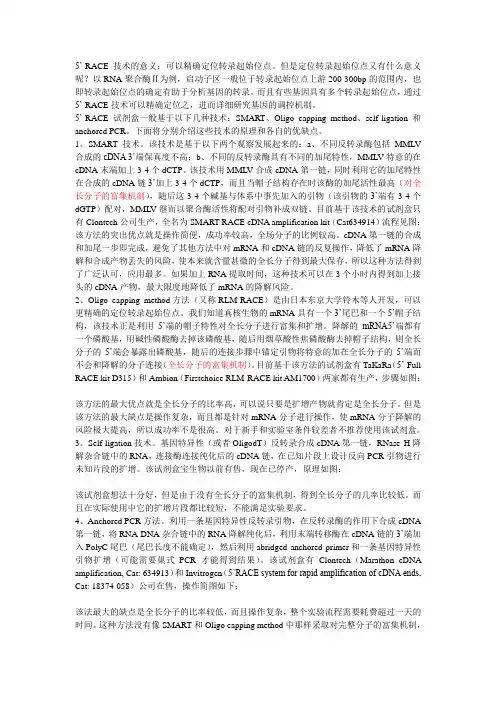
5’-RACE技术的意义:可以精确定位转录起始位点。
但是定位转录起始位点又有什么意义呢?以RNA聚合酶Ⅱ为例,启动子区一般位于转录起始位点上游200-300bp的范围内,也即转录起始位点的确定有助于分析基因的转录。
而且有些基因具有多个转录起始位点,通过5’-RACE技术可以精确定位之,进而详细研究基因的调控机制。
5’-RACE试剂盒一般基于以下几种技术:SMART、Oligo capping method、self-ligation和anchored PCR。
下面将分别介绍这些技术的原理和各自的优缺点。
1、SMART技术。
该技术是基于以下两个观察发展起来的:a、不同反转录酶包括MMLV 合成的cDNA 3’端保真度不高;b、不同的反转录酶具有不同的加尾特性,MMLV特意的在cDNA末端加上3-4个dCTP。
该技术用MMLV合成cDNA第一链,同时利用它的加尾特性在合成的cDNA链3’加上3-4个dCTP,而且当帽子结构存在时该酶的加尾活性最高(对全长分子的富集机制),随后这3-4个碱基与体系中事先加入的引物(该引物的3’端有3-4个dGTP)配对,MMLV继而以聚合酶活性将配对引物补成双链。
目前基于该技术的试剂盒只有Clontech公司生产,全名为SMART RACE cDNA amplification kit(Cat634914)流程见图:该方法的突出优点就是操作简便,成功率较高,全场分子的比例较高。
cDNA第一链的合成和加尾一步即完成,避免了其他方法中对mRNA和cDNA链的反复操作,降低了mRNA降解和合成产物丢失的风险,使本来就含量甚微的全长分子得到最大保存,所以这种方法得到了广泛认可,应用最多。
如果加上RNA提取时间,这种技术可以在3个小时内得到加上接头的cDNA产物,最大限度地降低了mRNA的降解风险。
2、Oligo capping method方法(又称RLM-RACE)是由日本东京大学铃木等人开发,可以更精确的定位转录起始位点。
BD SMART™ RACE cDNA Amplification Kit User ManualI. 简要概述II. 成分列表Control Human Placental Total RNA 和BD SMART II A Oligonucleotide在–70°C下保存。
NucleoTrap Gel Extraction Kit 室温下保存。
其余试剂–20°C下保存。
随BD SMART RACE cDNA Amplification Kit 同时免费提供BD PowerScript Reverse Transcriptase和BD Advantage 2 PCR Kit。
所有试剂可以满足7 次cDNA 合成反应和30次PCR反应。
First-strand cDNA 合成•7µl BD SMART II™ A Oligonucleotide (12 µM)5'–AAGCAGTGGTATCAACGCAGAGTACGCGGG–3'• 7µl 3'-RACE CDS Primer A (3'-CDS; 12 µM)5'–AAGCAGTGGTATCAACGCAGAGTAC(T)30V N–3'(N = A, C, G, or T; V = A, G, or C)• 7µl 5'-RACE CDS Primer (5'-CDS; 12 µM)5'–(T)25V N–3' (N = A, C, G, or T; V = A, G, or C)• 7µl BD PowerScript™ Reverse Tra nscriptase• 200 µl 5X First-Strand Buffer250 mM Tris-HCl (pH 8.3)375 mM KCl30 mM MgCl2• 200 µl Dithiothreitol (DTT; 20 mM)• 1ml Deionized H2O5'- & 3'-RACE PCR• 400 µl 10X Universal Primer A Mix (UPM)Long (0.4 µM):5'–CTAATACGACTCACTATAGGGCAAGCAGTGGTATCAACGCAGAGT–3'Short (2 µM):5'–CTAATACGACTCACTATAGGGC–3'• 50 µl Nested Universal Primer A (NUP; 10 µM)5'–AAGCAGTGGTATCAACGCAGAGT–3'Control Reagents• 5µl Control Human Placental Total RNA (1 µg/µl)• 25 µl Control 5'-RACE TFR Primer (10 µM)• 25 µl Control 3'-RACE TFR Primer (10 µM)General Reagents• 70 µl dNTP Mix (dATP, dCTP, dGTP, and dTTP, each at 10 mM)• 2 X 1 m l Tricine-EDTA Buffer10 mM Tricine-KOH (pH 8.5)1.0 mM EDTANucleoTrap® Gel Extraction Kit (Cat. No. 636053 or K3070-y)• 100 µl NucleoTrap Suspension• 3 ml NT1 Buffer• 10 ml NT2 Buffer• 2ml NT3 Buffer• User Manual (PT3169-1)Free trial-size BD Advantage™ 2 PCR Kit (Cat. No. 639207 or K1910-y)The BD Advantage 2 kit provides sufficient reagents for 30 PCR reactions. ` `The following components are included:• 30 µl 50X BD Advantage 2 Polymerase Mix• 200 µl 10X BD Advantage 2 PCR Buffer• 50 µl 50X dNTP Mix (10 mM each)• 30 µl Control DNA Template (100 ng/µl)• 30 µl Control Primer Mix (10 µM each)• 1 ml PCR-Grade Water• User Manual (PT3281-1)III. 另备物品下列试剂需另外准备:• 0.5-ml PCR 反应管,推荐使用PerkinElmer GeneAmp 0.5-ml reaction tubes (Cat. No.N801-0737 or N801-0180).• Mineral oil (e.g., Sigma Cat. No. M-3516)IV. BD SMART RACE的要点使用前请全面阅读•所有参数均经过优化,但可能因所使用的酶、模版、引物和热循环仪而不同。